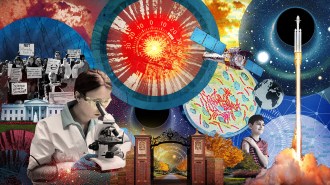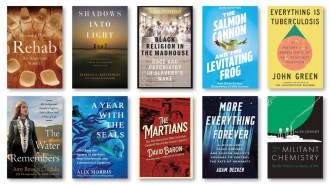Scientists embrace Twitter for spreading the word and hashing through new data
- More than 2 years ago
When NASA’s Mars rover Curiosity touched down on August 5, nerds of the Twitterverse went wild. The Jet Propulsion Laboratory team that sends out tweets on behalf of the rover (@MarsCuriosity) immediately posted the news: “I’m safely on the surface of Mars. GALE CRATER I AM IN YOU!!! #MSL”
Curiosity is not the first rover to communicate to the masses via Twitter; her siblings Spirit, Opportunity and Phoenix tweet too. But their numbers of followers pale next to the more than 1 million tuned in to Curiosity.
This rover began its journey in an age when more and more scientists are embracing social media platforms. Twitter is even preempting scientific announcement venues of old. In August, the discovery that the former planet Pluto had a previously unknown moon wasn’t announced at a news conference or in a scientific journal. It was tweeted by Alan Stern of the Southwest Research Institute in Boulder, Colo.: “Just announced: Pluto has some company — We’ve discovered a 5th moon using the Hubble Space Telescope!”
Scientists aren’t just using Twitter to tweet. They are also mining its data. Earlier this year, for example, scientists analyzed tweets and other social media posts about the cholera outbreak in Haiti after the 2010 earthquake. The spread of phrases such as #cholera turned out to track closely with disease reports from hospitals and clinics. Haiti’s Ministry of Public Health and Population made those reports available days or weeks after the outbreak; social media data were available almost instantly. Other studies have found that Twitter chatter during the 2009 swine flu outbreak provided a relatively accurate real-time estimate of the disease’s spread.
Seismologists are also using social media to gather earthquake data. Real-time earthquake-related messages (OMG! did you feel that? #earthquake) showed that within one minute of the Morgan Hill 2009 quake in California, the frequency of “earthquake” tweets rose from less than one per hour to about 150 per minute. U.S. Geological Survey scientists were even able to create a rough map of the shakiest areas by plotting tweets sent out in the first minute.
“I think we’ll see much more use of Twitter by scientists,” says Gilad Lotan, head of research and development for the social media analytics company SocialFlow. “When people are talking about events, you can use humanity as a sensor.”
That said, Lotan also emphasizes caveats. There’s the sampling problem: While an estimated 140 million people use Twitter, those people aren’t evenly distributed across the country or around the world. There’s also an age bias; Twitter, compared with other social media sites like Facebook, skews young. (With so many parents now on Facebook, teens are turning to Twitter, says Lotan.)
There’s also the difficulty in interpreting messages that are only 140 characters long — that’s the limit for a tweet. There’s no room for context. And that can lead to serious misinterpretation of what’s being tweeted.
Lotan recently demonstrated these dangers with a cringe-worthy example. When news broke about the movie theater shootings in Aurora, Colo., Lotan began collecting Twitter hashtag data about the event. (For those of you who remain blithely outside the Twitterverse, the hashtag symbol in front of a word or phrase in the tweet associates that tweet with a particular topic or idea.) The plotted graph of #Aurora over time looked weird. Instead of seeing a big spike in the data that gradually slopes to a close, there were two spikes. And the second one was about five times as tall as the first.
So Lotan and colleagues created a word co-occurrence graph, which diagrammed the words that appeared along with #Aurora. The most frequent such words during the second spike were @CelebBoutique, Shop and Kim. It turns out that a fashion boutique in the United Kingdom sells a white V-neck dress inspired by Kim Kardashian and dubbed “the Aurora.” When the boutique’s tweeters and other dress/Kim fans saw #Aurora on Twitter, they thought people were talking about the dress and began to tweet with the same hashtag. Soon the fans’ tweets were retweeted through the Twitterverse. “Kim Kardashian is always messing up our data,” quips Lotan.
Social media scientists have a term for this: context collapse. It refers to the everyone-may-be-watching nature of social media. When interacting with a finite, limited group of people such as family or people at work, we adjust our tone and presentation slightly to that social context. But in the infinitely open audience of social media, that context can collapse, worlds can collide and misinterpretations abound.
A recent tweet from Curiosity provided a much more lighthearted example. On September 22, @MarsCuriosity quipped: “I did a science! 1st contact science on rock target Jake. Here’s an action shot pic.twitter.com/pzcgH6Bk.” For those on Twitter who follow Curiosity’s unofficial snarky doppelgänger, @SarcasticRover, that tweet had hidden meaning. “I did a science” is one of @SarcasticRover’s catchphrases. To someone out of the know, it looked like JPL’s team needed a lesson in grammar.
SN Prime | October 15, 2012 | Vol. 2, No. 39







